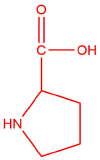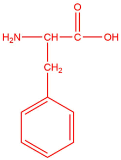13.E: Amino Acids and Proteins (Exercises)
- Page ID
- 59422
\( \newcommand{\vecs}[1]{\overset { \scriptstyle \rightharpoonup} {\mathbf{#1}} } \)
\( \newcommand{\vecd}[1]{\overset{-\!-\!\rightharpoonup}{\vphantom{a}\smash {#1}}} \)
\( \newcommand{\id}{\mathrm{id}}\) \( \newcommand{\Span}{\mathrm{span}}\)
( \newcommand{\kernel}{\mathrm{null}\,}\) \( \newcommand{\range}{\mathrm{range}\,}\)
\( \newcommand{\RealPart}{\mathrm{Re}}\) \( \newcommand{\ImaginaryPart}{\mathrm{Im}}\)
\( \newcommand{\Argument}{\mathrm{Arg}}\) \( \newcommand{\norm}[1]{\| #1 \|}\)
\( \newcommand{\inner}[2]{\langle #1, #2 \rangle}\)
\( \newcommand{\Span}{\mathrm{span}}\)
\( \newcommand{\id}{\mathrm{id}}\)
\( \newcommand{\Span}{\mathrm{span}}\)
\( \newcommand{\kernel}{\mathrm{null}\,}\)
\( \newcommand{\range}{\mathrm{range}\,}\)
\( \newcommand{\RealPart}{\mathrm{Re}}\)
\( \newcommand{\ImaginaryPart}{\mathrm{Im}}\)
\( \newcommand{\Argument}{\mathrm{Arg}}\)
\( \newcommand{\norm}[1]{\| #1 \|}\)
\( \newcommand{\inner}[2]{\langle #1, #2 \rangle}\)
\( \newcommand{\Span}{\mathrm{span}}\) \( \newcommand{\AA}{\unicode[.8,0]{x212B}}\)
\( \newcommand{\vectorA}[1]{\vec{#1}} % arrow\)
\( \newcommand{\vectorAt}[1]{\vec{\text{#1}}} % arrow\)
\( \newcommand{\vectorB}[1]{\overset { \scriptstyle \rightharpoonup} {\mathbf{#1}} } \)
\( \newcommand{\vectorC}[1]{\textbf{#1}} \)
\( \newcommand{\vectorD}[1]{\overrightarrow{#1}} \)
\( \newcommand{\vectorDt}[1]{\overrightarrow{\text{#1}}} \)
\( \newcommand{\vectE}[1]{\overset{-\!-\!\rightharpoonup}{\vphantom{a}\smash{\mathbf {#1}}}} \)
\( \newcommand{\vecs}[1]{\overset { \scriptstyle \rightharpoonup} {\mathbf{#1}} } \)
\( \newcommand{\vecd}[1]{\overset{-\!-\!\rightharpoonup}{\vphantom{a}\smash {#1}}} \)
\(\newcommand{\avec}{\mathbf a}\) \(\newcommand{\bvec}{\mathbf b}\) \(\newcommand{\cvec}{\mathbf c}\) \(\newcommand{\dvec}{\mathbf d}\) \(\newcommand{\dtil}{\widetilde{\mathbf d}}\) \(\newcommand{\evec}{\mathbf e}\) \(\newcommand{\fvec}{\mathbf f}\) \(\newcommand{\nvec}{\mathbf n}\) \(\newcommand{\pvec}{\mathbf p}\) \(\newcommand{\qvec}{\mathbf q}\) \(\newcommand{\svec}{\mathbf s}\) \(\newcommand{\tvec}{\mathbf t}\) \(\newcommand{\uvec}{\mathbf u}\) \(\newcommand{\vvec}{\mathbf v}\) \(\newcommand{\wvec}{\mathbf w}\) \(\newcommand{\xvec}{\mathbf x}\) \(\newcommand{\yvec}{\mathbf y}\) \(\newcommand{\zvec}{\mathbf z}\) \(\newcommand{\rvec}{\mathbf r}\) \(\newcommand{\mvec}{\mathbf m}\) \(\newcommand{\zerovec}{\mathbf 0}\) \(\newcommand{\onevec}{\mathbf 1}\) \(\newcommand{\real}{\mathbb R}\) \(\newcommand{\twovec}[2]{\left[\begin{array}{r}#1 \\ #2 \end{array}\right]}\) \(\newcommand{\ctwovec}[2]{\left[\begin{array}{c}#1 \\ #2 \end{array}\right]}\) \(\newcommand{\threevec}[3]{\left[\begin{array}{r}#1 \\ #2 \\ #3 \end{array}\right]}\) \(\newcommand{\cthreevec}[3]{\left[\begin{array}{c}#1 \\ #2 \\ #3 \end{array}\right]}\) \(\newcommand{\fourvec}[4]{\left[\begin{array}{r}#1 \\ #2 \\ #3 \\ #4 \end{array}\right]}\) \(\newcommand{\cfourvec}[4]{\left[\begin{array}{c}#1 \\ #2 \\ #3 \\ #4 \end{array}\right]}\) \(\newcommand{\fivevec}[5]{\left[\begin{array}{r}#1 \\ #2 \\ #3 \\ #4 \\ #5 \\ \end{array}\right]}\) \(\newcommand{\cfivevec}[5]{\left[\begin{array}{c}#1 \\ #2 \\ #3 \\ #4 \\ #5 \\ \end{array}\right]}\) \(\newcommand{\mattwo}[4]{\left[\begin{array}{rr}#1 \amp #2 \\ #3 \amp #4 \\ \end{array}\right]}\) \(\newcommand{\laspan}[1]{\text{Span}\{#1\}}\) \(\newcommand{\bcal}{\cal B}\) \(\newcommand{\ccal}{\cal C}\) \(\newcommand{\scal}{\cal S}\) \(\newcommand{\wcal}{\cal W}\) \(\newcommand{\ecal}{\cal E}\) \(\newcommand{\coords}[2]{\left\{#1\right\}_{#2}}\) \(\newcommand{\gray}[1]{\color{gray}{#1}}\) \(\newcommand{\lgray}[1]{\color{lightgray}{#1}}\) \(\newcommand{\rank}{\operatorname{rank}}\) \(\newcommand{\row}{\text{Row}}\) \(\newcommand{\col}{\text{Col}}\) \(\renewcommand{\row}{\text{Row}}\) \(\newcommand{\nul}{\text{Nul}}\) \(\newcommand{\var}{\text{Var}}\) \(\newcommand{\corr}{\text{corr}}\) \(\newcommand{\len}[1]{\left|#1\right|}\) \(\newcommand{\bbar}{\overline{\bvec}}\) \(\newcommand{\bhat}{\widehat{\bvec}}\) \(\newcommand{\bperp}{\bvec^\perp}\) \(\newcommand{\xhat}{\widehat{\xvec}}\) \(\newcommand{\vhat}{\widehat{\vvec}}\) \(\newcommand{\uhat}{\widehat{\uvec}}\) \(\newcommand{\what}{\widehat{\wvec}}\) \(\newcommand{\Sighat}{\widehat{\Sigma}}\) \(\newcommand{\lt}{<}\) \(\newcommand{\gt}{>}\) \(\newcommand{\amp}{&}\) \(\definecolor{fillinmathshade}{gray}{0.9}\)These are homework exercises to accompany Chapter 13 of the University of Kentucky's LibreText for CHE 103 - Chemistry for Allied Health.
Questions
(click here for solutions)
Q13.1.1
Read the material at http://hyperphysics.phy-astr.gsu.edu/hbase/organic/essam.html and answer the following questions:
a. What are essential amino acids?
b. What are nonessential amino acids?
c. What happens if you are deficient in an amino acid?
Q13.1.2
Draw the functional groups present in all amino acids.
Q13.1.3
Complete the following for threonine, lysine, and tyrosine.
a. Draw the amino acid.
b. Circle the side chain.
c. Identify whether it is polar, nonpolar, acidic, or basic.
d. At what pH will it exist as a zwitterion?
e. What is the range of pH values when it will be positively charged?
f. What is the range of pH values when it will be negatively charged?
(click here for solutions)
Q13.2.1
Draw the two dipeptides formed from each pair of amino acids.
a. tyrosine and lysine
b. threonine and gluatmine
c. alanine and histidine
Q13.2.2
Draw and give the full names of the amino acids in the following dipeptides.
Q13.2.3
List of all of the possible polypeptides that can be formed from threonine, alanine, and phenylalanine (use three character abbreviations for each amino acid).
Q13.2.4
Draw the following polypeptides.
a. Ser-Tyr-Gln
b. Lys-Met-Gly
Q13.2.5
Identify each of the amino acids in the polypeptide and then name it using the three character abbreviations.
(click here for solutions)
Q13.3.1
Describe the four levels of protein structure.
Q13.3.2
What levels of structure involve hydrogen bonding?
Q13.3.3
What types of structure is the result of interactions between amino acids that are far apart in the primary structure?
Q13.3.4
What types of interactions hold the secondary structure together?
Q13.3.5
What types of interactions hold the tertiary structure together?
Q13.3.6
What levels of structure are affected by denaturation?
Q13.3.7
A protein has one subunit. Would it have a quaternary structure?
Answers
13.1: Amino Acids
Q13.1.1
a. Essential amino acids are those you get from your diet.
b. Nonessential amino acids are produced in the body.
c. Illness and/or degradation of body's proteins.
Q13.1.2

amine and carboxylic acid
Q13.1.3
Complete the following for threonine, lysine, and tyrosine.
threonine

- polar
- 5.60
- < 5.60
- > 5.60
lysine

- basic
- 9.47
- < 9.47
- > 9.47
tyrosine

- polar
- 5.63
- < 5.63
- > 5.63
13.2: Peptides
Q13.2.1
Draw the two dipeptides formed from each pair of amino acids.
a. 
b. 
c. 
Q13.2.2
| a. | alanine  |
glycine  |
| b. | proline  |
phenylalanine  |
| c. | tryptophan  |
lysine  |
Q13.2.3
Thr-Ala-Phe
Thr-Phe-Ala
Ala-Thr-Phe
Ala-Phe-Thr
Phe-Ala-Thr
Phe-Thr-Ala
Q13.2.4
a. 
b. 
Q13.2.5

Arg-His-Thr-Glu-Ser
13.3: Protein Structure
Q13.3.1
Primary - sequence of amino acids
Secondary - alpha helix and Beta-pleated sheets held together by hydrogen bonds
Tertiary - third level of structure of protein often forming globular or fibrous structure, held together by variety of attractive forces
Quaternary - complex of multiple proteins held together to function as one, held together by variety of attractive forces (same as tertiary)
Q13.3.2
secondary, tertiary, and quaternary structures
Q13.3.3
tertiary structures
Q13.3.4
hydrogen bonds
Q13.3.5
London dispersion forces, hydrogen bonds, dipole-dipole forces, ion-dipole interactions, salt bridges, and disulfide bonds
Q13.3.6
secondary, tertiary, and quaternary
Q13.3.7
No, a quaternary structure must have multiple subunits.

